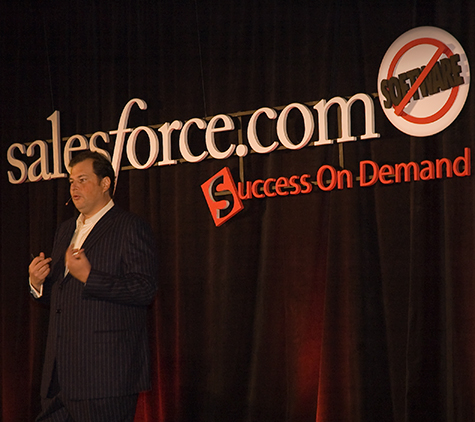Salesforce.com's bold development platform vision [includes executive podcast]

Note: Click the player to listen to my podcast interview with Steve Cakebread, President and Chief Strategy Officer of Salesforce.com. Steve comments on his company's strategy, discusses on-premises software, and presents Salesforce.com's vision for mobile devices.
Salesforce.com's Tour de Force roadshow is traveling around the world to present the company's platform as a service (PaaS) strategy, which it calls Force.com. According to Marc Benioff, Salesforce.com's ebullient CEO, the company's long-term vision for PaaS represents nothing less a sea change for software development.

Salesforce.com wants to be, "The world’s first multi-application, multi-category SaaS company." To achieve this goal, Salesforce has built a rich set of programming, user interface, and rapid development tools to attract developers and ease their transition to the Force.com platform.
The strategy is based on the notion of utility computing, where developers offload certain functions, such as database hosting and administration, onto Force.com, which becomes, in effect, a low-cost, commodity infrastructure service provider. With this strategy, Salesforce hopes to reduce its customers' development cost, lower complexity and risk, and shorten development cycle times
This paradigm extends the company's core SaaS application-delivery model, based on a multi-tenant technical architecture, to a full range of backend web services. The following slide shows the development activities and infrastructure that Salesforce is attempting to centralize and commoditize with economies of scale:
According to Salesforce, the Force.com platform consists of services that address key components in the development workflow, so programmers can focus on high-value activities such as core application functionality. Here's a high-level architectural diagram of Force.com:
THE PROJECT FAILURES ANALYSIS
Salesforce.com has divided the software development lifecycle into high- and low-value activities to drive commodity traffic to its platform. Although it's an impressive and sweeping vision, to achieve market-leading traction Salesforce must overcome certain obstacles.
Change management. While developers can split off and outsource certain activities, organizational and cultural issues around software development and deployment still remain. Training and change management, for example, remain important determinants of project success in both the on-premises and outsourced paradigms.
In addition, outsourcing requires developers, users, and management to adopt a new set of expectations around development timeframes and workflows. For example, Analog Devices' Worldwide CRM Strategy Manager, Cheryl O'Conner, a satisfied Force.com customer, said the rapid release cycles made possible with outsourcing can wreak havoc on user education, because training materials can remain perpetually out of date.
These concerns will diminish over time, as the market adapts to outsourced development, but they are real issues today.
Process maturity and application heterogeneity. I believe Salesforce eventually plans to offer a "virtual software suite" to encourage it's customers to dispense with the likes of SAP, Oracle, and other on-premises enterprise solutions. Several substantial obstacles militate against Salesforce realizing this vision anytime soon.
Large enterprise vendors typically offer industry-specific best practices, in the form of well-established processes and workflows, embedded in their software suites. These proven practices, often created over the course of many years, frequently drive the business transformation efforts that lie behind successful software implementations.
While software development under Force.com may be faster than using traditional methods, process maturity across multiple industries and business functions is independent of development speed. Salesforce must address this issue to compete successfully against larger, more established, packaged application vendors.
Additional considerations for customers seeking to purchase a virtual product suite from components offered on Force.com include the lack of coordinated, single-vendor responsibility over application functionality, master data management, user interface, and so on. Since Force.com is a platform, who will be designated as controlling authority over integration among the components? This will be a strategically challenging issue for Salesforce.com.
Without centralized control, Force.com could become like Windows--disorganized, bloated, internally inconsistent--rather than sleek, clean, and friendly like the Macintosh.
On-premises is sometimes necessary. Both outsourced and traditional on-premises software have a legitimate place in the world. For example, hosted outsourcing is not acceptable in certain environments, such as financial services, where security concerns are paramount. Even CODA's CEO, Jeremy Roche, another enthusiastic Force.com customer, acknowledged that his on-premises product line is here to stay.
The big question: will developers buy it? The development tools landscape is littered with companies who once offered innovative languages, rapid development frameworks, and integrated programming environments. Symantec and Borland, to name two examples among many, were forced to exit the development tools business years ago.
Developers don't make the platform decision lightly or quickly, so winning their hearts and minds is a time-consuming and highly risky proposition. Nonetheless, the new paradigm is compelling, interesting, and undeniably cool; the concept, platform, and strategy also make intuitive sense. Clearly, this battle is worthy of careful observation.